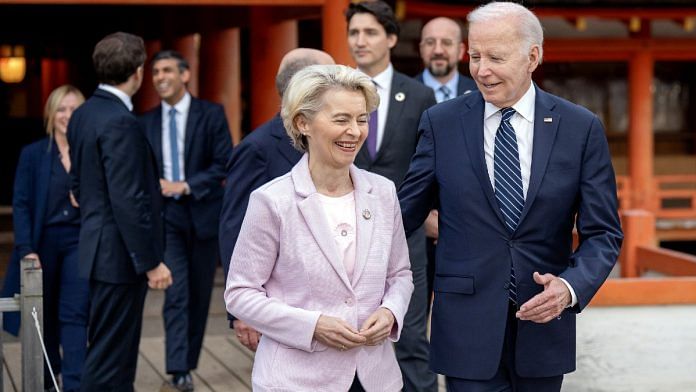New Delhi: Largely ignored amid news about US-led proposals for new Middle-East freight corridors was a major announcement from the US and EU, on the G20 sidelines, about a trade corridor through sub-Saharan Africa.
On the margins of the Partnership for Global Infrastructure and Investment (PGII) event at the G20 Summit in New Delhi, the US and the EU expressed support for the Lobito Corridor, which seeks to connect ports in Angola to Zambia and the Democratic Republic of Congo — home to major deposits of cobalt, lithium and copper.
The three African countries had in July committed to the Lobito Corridor, of deep significance in light of the global shift towards electric vehicles. While Angola lies on Africa’s western coast, Zambia is completely landlocked and DRC largely so.
The PGII, aimed at narrowing the infrastructure gap in developing countries, is a G7 initiative seen as a counter to China’s Belt and Road Initiative (BRI), under which it offers loans to developing countries with the ostensible aim of building infrastructure.
Among other things, the Lobito project is likely to enhance Indian access to critical minerals, which China has been trying to corner.
Critical minerals are crucial not just for the shift to green energy but also for developing semiconductors, among other things.
The Trans-African corridor will connect the mineral-rich Katanga province in the DRC, located in central Africa, to the Atlantic port of Lobito in Angola, through the copper belt in Zambia.
Katanga is reportedly the richest province in the DRC, with reserves of gold, silver, diamonds, coltan, uranium, platinum, cobalt, cassiterite and copper, according to a report in the London-based magazine African Business.
“…the United States of America and the European Union welcomed the recent commitment by Angola, Zambia and the Democratic Republic of the Congo to develop the Lobito Corridor connecting southern Democratic Republic of the Congo and northwestern Zambia to regional and global trade markets via the Port of Lobito in Angola,” the EU-US joint statement said.
This project is also noteworthy as China displaced the US as Africa’s largest trading partner in 2009. Through the BRI, China has reportedly invested $155 billion in projects in sub-Saharan Africa in the last two decades, according to a report in Nikkei Asia.
During the PGII event, US President Joe Biden said, “In… sub-Saharan Africa — we’re working in a private-public partnership as well to invest in a Trans-African Corridor. That includes a new partner, the European Union.”
“Together, as part of this corridor, we’re going to invest in a new rail line that will extend from the western port in Angola, to the — the DRC, to Zambia, and, ultimately, the Indian Ocean,” Biden added.
The PGII was first announced in 2022 during the G7 Leaders’ meet in Germany. The G7 leaders agreed to collectively mobilise $600 billion over five years as an offer to narrow the “investment gap for sustainable, inclusive, climate resilient, and quality infrastructure in emerging markets and developing countries”, according to the June 2022 G7 Leaders’ communique.
Also Read: China’s gallium monopoly a red flag for US & its allies. 5 steps to de-risk supply chains
‘Game-changing regional investment’
President Biden described the Trans-African project as more than just “laying tracks”, calling it a “game-changing regional investment”.
“It’s about creating jobs, increasing trade, strengthening the supply chains, boosting connectivity, laying foundations that will strengthen commerce and food security for people across multiple countries. This is a game-changing regional investment,” he said.
European Commission President Ursula von der Leyen said during the PGII event that the “goal is not only to connect a landlocked region to the sea”.
“Our partnership will also invest in local value chains, in clean energy and in skills for the local workforce,” she added.
“This is the spirit of PGII: It is a whole new approach to large infrastructure investment. It is about shared prosperity. It is about real benefits for all partners,” she said.
According to the EU-US joint statement, “to accelerate this work in partnership with the three African countries, the European Union and the United States are teaming up to support the development of the corridor, including by launching feasibility studies for a new greenfield rail line expansion between Zambia and Angola”.
“This builds on the initial US-led support to refurbish the railway section from the Lobito port in Angola to the DRC,” the statement added.
The US-EU partnership, the statement said, “will upgrade critical infrastructure across sub-Saharan Africa to unlock the enormous potential of this region”.
“We are excited to join forces to generate economic benefits with our partners in Angola, the Democratic Republic of the Congo and Zambia,” it added.
Zambia defaulted on its sovereign debt in 2020 and only in June this year reached a deal with its creditors, including China, to restructure the $6.3 billion it reportedly owes to governments abroad.
(Edited by Sunanda Ranjan)
Also Read: How joining Minerals Security Partnership can help India harness critical minerals potential



